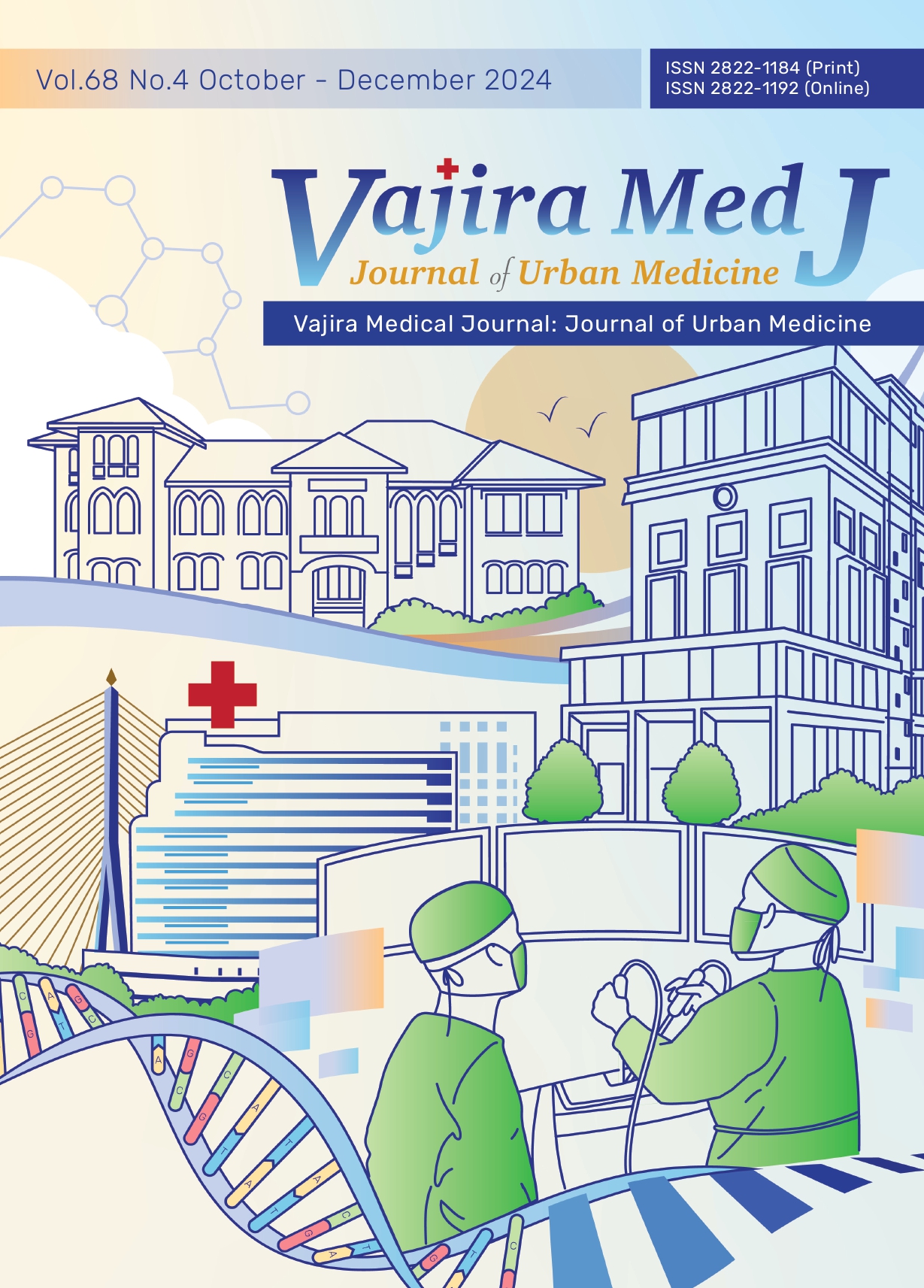Prevalence of 2-Year Breastfeeding among Thai Mothers and Associated Factors of Achievement 2-Year Breastfeeding among Thai Mothers
Main Article Content
Abstract
OBJECTIVE: To assess 2-year breastfeeding (BF) rate and factors for the achievement of 2-year BF.
METHODS: This cross-sectional study was conducted between June 27 and December 11, 2023 by an electronic online questionnaire. Thai mothers with babies aged more than 2 years who registered on Facebook page of one author and could recall their infant’s 2-year feeding pattern were included in the study. Participating mothers completed a questionnaire covering personal data, history of BF pattern of previous and current child, and knowledge and attitude toward BF. The rate of 2-year BF and factors for the achievement were analyzed by univariate and multivariate analyses.
RESULTS: The included mothers had a mean age of 36.2 ± 4.7 years, and 94.1% reported BF for at least 2 years. Among favorable features, only four exhibited a significant association with 2-year BF according to the univariate analysis: age > 36 years (odds ratio (OR) 3.07, 95% confidence interval (CI) 1.90-4.95, p-value < 0.001), being self-employed or working from home (OR: 2.60, 95% CI 1.64-4.10, p-value < 0.001), used contraception within 2 years postpartum (OR: 2.07, 95% CI 1.08-3.97, p-value = 0.025), and good history of 2-year BF in their previous child (OR: 4.71, 95% CI 1.96-11.28, p-value < 0.001). Multivariate analysis revealed that only the mothers with a history of 2-year BF in their previous child was the only independent feature associated with their current 2-year BF (adjusted OR: 5.25, 95% CI 1.61-17.07, p-value = 0.006).
CONCLUSION: The results of this study revealed a high rate of 2-year BF among the studied mothers. The only independent factor for a 2-year BF was a mother’s history of 2-year BF with their previous child.
Downloads
Article Details

This work is licensed under a Creative Commons Attribution-NonCommercial-NoDerivatives 4.0 International License.
References
World Health Organization, United Nations Children’s Fund. Global breastfeeding scorecard, 2019: increasing commitment to breastfeeding through funding and improved policies and programs [internet]. 2019 [cited 2023 Mar 15]. Available from: https://apps.who.int/iris/handle/10665/326049
World Health Organization. Infant and young child feeding [internet]. 2023 [cited 2024 May 8]. Available from: https://www.who.int/news-room/fact-sheets/detail/infant-andyoung-child-feeding
Victora CG, Bahl R, Barros AJ, França GV, Horton S, Krasevec J, et al. Breastfeeding in the 21st century: epidemiology, mechanisms, and lifelong effect. Lancet 2016;387(10017):475-90.
Global Breastfeeding Collective. Global breastfeeding scorecard [internet]. 2023 [cited 2024 May 8]. Available from: https://www.unicef.org/media/150586/file/Global%20breastfeeding%20scorecard%202023.pdf
Delgado C, Matijasevich A. Breastfeeding up to two years of age or beyond and its influence on child growth and development: a systematic review. Cad Saude Publica 2013;29(2):243-56.
Zong X, Wu H, Zhao M, Magnussen CG, Xi B. Global prevalence of WHO infant feeding practices in 57 LMICs in 2010-2018 and time trends since 2000 for 44 LMICs. EClinical Medicine 2021;37:100971.
UNICEF Thailand. UNICEF finds 1 in 3 mothers in Thailand exclusively breastfeed their babies, far below target [internet]. 2023 [cited 2024 May 9]. Available from: https://www.unicef.org/thailand/press-releases/uniceffinds-1-3-mothers-thailand-exclusively-breastfeed-their-babies-far-below
Keskomon T, Pansang K, Poungjuntaradej N, Klinsukon C, Boonleart D, Thongkam P, et al. Factors affecting breastfeeding during 6 months to 2 years of adolescent at police general hospital. JRTAN 2022;23(3):494-503.
Yimyam S, Morrow M, Srisuphan W. Role conflict and rapid socio-economic change: breastfeeding among employed women in Thailand. Soc Sci Med 1999;49(7):957-65.
Time Champ. What is the average salary in Thailand? And trend analysis [internet]. 2023 [cited 2024 Jul 22]. Available from: https://www.timechamp.io/blogs/what-is-the-average-salary-in-thailand-and-trend-analysis/
Bloom BS. Learning for mastery. Instruction and curriculum. Regional Education Laboratory for the Carolinas and Virginia, topical papers and reprints, number 1. Eval Comment 1968;1(2):12.
Doma H, Tran TD, Tran T, Hanieh S, Tran H, Nguyen T, et al. Continuing breastfeeding for at least two years after birth in rural Vietnam: prevalence and psychosocial characteristics. Int Breastfeed J 2021;16(1):78.
Vieira GO, de Oliveira Vieira T, da Cruz Martins C, de Santana Xavier Ramos M, Giugliani ERJ. Risk factors for and protective factors against breastfeeding interruption before 2 years: a birth cohort study. BMC Pediatr 2021;21(1):310.
Yang Z, Ding Y, Song S, Zhang Y, Li A, Su M, et al. Factors affecting the breastfeeding duration of infants and young children in China: a cross-sectional study. Nutrients 2023;15(6):1353.
Scott J, Ahwong E, Devenish G, Ha D, Do L. Determinants of continued breastfeeding at 12 and 24 months: results of an Australian cohort study. Int J Environ Res Public Health 2019;16(20):3980.
Santana GS, Giugliani ERJ, Vieira TO, Vieira GO. Factors associated with breastfeeding maintenance for 12 months or more: a systematic review. J Pediatr (Rio J) 2018;94(2):104-22.
Agnafors S, Bladh M, Svedin CG, Sydsjö G. Mental health in young mothers, single mothers and their children. BMC Psychiatry 2019;19(1):112.
Mendes MS, Schorn M, Santo LCDE, Oliveira LD, Giugliani ERJ. Factors associated with breastfeeding continuation for 12 months or more among working mothers in a general hospital. Cien Saude Colet 2021;26(11):5851-60.
Kozachenko J, Kivite-Urtane A, Berzina F, Stolcere IE, Lazdane G. The association of longer breastfeeding duration and socioeconomic, pregnancy, childbirth and postpartum characteristics. Medicina (Kaunas) 2024;60(5):792.
Rostamkhan S, Lakeh NM, Asiri S, Leili EK. Breastfeeding up to two years of age and its’ associated factors based on behaviors, attitudes, subjective norms, and enabling factors (BASNEF) model. J Holist Nurs Midwifery 2020;30(1):9-16.
Paramashanti BA, Dibley MJ, Huda TM, Prabandari YS, Alam NA. Factors influencing breastfeeding continuation and formula feeding beyond six months in rural and urban households in Indonesia: a qualitative investigation. Int Breastfeed J 2023;18(1):48.
Jacobzon A, Engström Å, Lindberg B, Gustafsson SR. Mothers’ strategies for creating positive breastfeeding experiences: a critical incident study from Northern Sweden. Int Breastfeed J 2022 8;17(1):35.


